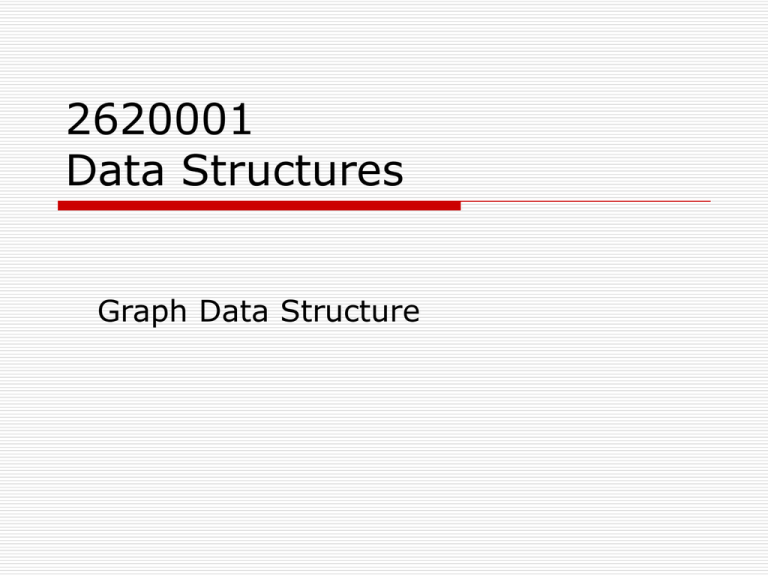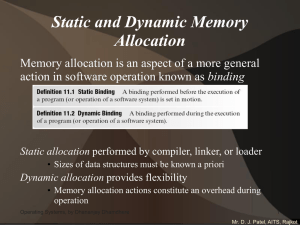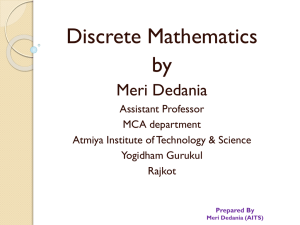Graph - DJPATEL.COM
advertisement

2620001
Data Structures
Graph Data Structure
What is a graph?
A data structure that consists of a set of
nodes (vertices) and a set of edges that
relate the nodes to each other
The set of edges describes relationships
among the vertices
620001 – Data Structures
Mr. Deven Patel , AITS, Rajkot
Formal definition of graphs
A graph G is defined as follows:
G=(V,E)
V(G): a finite, nonempty set of
vertices
E(G): a set of edges (pairs of
vertices)
620001 – Data Structures
Mr. Deven Patel , AITS, Rajkot
Directed vs. undirected graphs
When the edges in a graph have no
direction, the graph is called
undirected
620001 – Data Structures
Mr. Deven Patel , AITS, Rajkot
Directed vs. undirected graphs
(cont.)
When the edges in a graph have a
direction, the graph is called directed (or
digraph)
Warning: if the graph is
directed, the order of the
vertices in each edge is
important !!
E(Graph2) = {(1,3) (3,1) (5,9) (9,11) (5,7) (11,1) (9,9)}
620001 – Data Structures
Mr. Deven Patel , AITS, Rajkot
Trees vs graphs
Trees are special cases of graphs!!
620001 – Data Structures
Mr. Deven Patel , AITS, Rajkot
Graph terminology
Adjacent nodes: two nodes are adjacent if
they are connected by an edge
5 is adjacent to 7
7 is adjacent from 5
Path: a sequence of vertices that connect
two nodes in a graph
Complete graph: a graph in which every
vertex is directly connected to every other
vertex
620001 – Data Structures
Mr. Deven Patel , AITS, Rajkot
Graph terminology (cont.)
What is the number of edges in a complete
directed graph with N vertices?
N * (N-1)
2
O( N )
620001 – Data Structures
Mr. Deven Patel , AITS, Rajkot
Graph terminology (cont.)
What is the number of edges in a
complete undirected graph with N
vertices?
N * (N-1) / 2
2
O( N )
620001 – Data Structures
Mr. Deven Patel , AITS, Rajkot
Graph terminology (cont.)
Weighted graph: a graph in which each
edge carries a value
620001 – Data Structures
Mr. Deven Patel , AITS, Rajkot
Graph implementation
Array-based implementation
A 1D array is used to represent the
vertices
A 2D array (adjacency matrix) is used
to represent the edges
620001 – Data Structures
Mr. Deven Patel , AITS, Rajkot
Array-based implementation
620001 – Data Structures
Mr. Deven Patel , AITS, Rajkot
620001 – Data Structures
Mr. Deven Patel , AITS, Rajkot
Graph implementation (cont.)
Linked-list implementation
A 1D array is used to represent the vertices
A list is used for each vertex v which
contains the vertices which are adjacent
from v (adjacency list)
620001 – Data Structures
Mr. Deven Patel , AITS, Rajkot
Linked-list implementation
620001 – Data Structures
Mr. Deven Patel , AITS, Rajkot
620001 – Data Structures
Mr. Deven Patel , AITS, Rajkot
Graph searching
Problem: find a path between two
nodes of the graph (e.g., Austin and
Washington)
Methods: Depth-First-Search (DFS) or
Breadth-First-Search (BFS)
620001 – Data Structures
Mr. Deven Patel , AITS, Rajkot
Depth-First-Search (DFS)
What is the idea behind DFS?
Travel as far as you can down a path
Back up as little as possible when you
reach a "dead end" (i.e., next vertex has
been "marked" or there is no next
vertex)
DFS can be implemented efficiently
using a stack
620001 – Data Structures
Mr. Deven Patel , AITS, Rajkot
Use of a stack
It is very common to use a stack to
keep track of:
nodes to be visited next, or
nodes that we have already visited.
Typically, use of a stack leads to a
depth-first visit order.
Depth-first visit order is “aggressive”
in the sense that it examines
complete paths.
620001 – Data Structures
Mr. Deven Patel , AITS, Rajkot
Graph Traversals
•Both take time: O(V+E)
620001 – Data Structures
Mr. Deven Patel , AITS, Rajkot
start
end
(initialization)
620001 – Data Structures
Mr. Deven Patel , AITS, Rajkot
620001 – Data Structures
Mr. Deven Patel , AITS, Rajkot
620001 – Data Structures
Mr. Deven Patel , AITS, Rajkot
(BFS)
What is the idea behind BFS?
Look at all possible paths at the same
depth before you go at a deeper level
Back Breadth-First-Searching up as far
as possible when you reach a "dead end"
(i.e., next vertex has been "marked" or
there is no next vertex)
BFS can be implemented efficiently
using a Queue
620001 – Data Structures
Mr. Deven Patel , AITS, Rajkot
Use of a queue
It is very common to use a queue to
keep track of:
nodes to be visited next, or
nodes that we have already visited.
Typically, use of a queue leads to a
breadth-first visit order.
Breadth-first visit order is “cautious”
in the sense that it examines every
path of length i before going on to
paths of length i+1.
620001 – Data Structures
Mr. Deven Patel , AITS, Rajkot
start
end
(initialization)
620001 – Data Structures
Mr. Deven Patel , AITS, Rajkot
next:
620001 – Data Structures
Mr. Deven Patel , AITS, Rajkot
620001 – Data Structures
Mr. Deven Patel , AITS, Rajkot
Breadth First Search
2
s
5
3
620001 – Data Structures
4
8
7
6
9
Mr. Deven Patel , AITS, Rajkot
Breadth1 First Search
Shortest path
from s
0
2
s
4
5
3
8
7
6
9
Undiscovered
Discovered
Queue: s
Top of queue
Finished
620001 – Data Structures
Mr. Deven Patel , AITS, Rajkot
Breadth1 First Search
2
0
s
4
5
3
8
7
6
9
1
Undiscovered
Discovered
Queue: s 2
Top of queue
Finished
620001 – Data Structures
Mr. Deven Patel , AITS, Rajkot
Breadth1 First Search
2
0
4
5
s
8
7
1
3
6
9
1
Undiscovered
Discovered
Queue: s 2 3
Top of queue
Finished
620001 – Data Structures
Mr. Deven Patel , AITS, Rajkot
Breadth1 First Search
2
0
s
4
5
8
7
1
3
6
9
1
Undiscovered
Discovered
Queue: 2 3 5
Top of queue
Finished
620001 – Data Structures
Mr. Deven Patel , AITS, Rajkot
2
Breadth1 First Search
2
0
s
4
5
8
7
1
3
6
9
1
Undiscovered
Discovered
Queue: 2 3 5
Top of queue
Finished
620001 – Data Structures
Mr. Deven Patel , AITS, Rajkot
2
Breadth1 First Search
2
0
s
4
5 already discovered:
7
don't enqueue
5
1
3
8
6
9
1
Undiscovered
Discovered
Queue: 2 3 5 4
Top of queue
Finished
620001 – Data Structures
Mr. Deven Patel , AITS, Rajkot
2
Breadth1 First Search
2
0
s
4
5
8
7
1
3
6
9
1
Undiscovered
Discovered
Queue: 2 3 5 4
Top of queue
Finished
620001 – Data Structures
Mr. Deven Patel , AITS, Rajkot
2
Breadth1 First Search
2
0
s
4
5
8
7
1
3
6
9
1
Undiscovered
Discovered
Queue: 3 5 4
Top of queue
Finished
620001 – Data Structures
Mr. Deven Patel , AITS, Rajkot
2
Breadth1 First Search
2
0
s
4
5
8
7
1
3
6
1
2
9
Undiscovered
Discovered
Queue: 3 5 4
Top of queue
Finished
620001 – Data Structures
Mr. Deven Patel , AITS, Rajkot
2
Breadth1 First Search
2
0
s
4
5
8
7
1
3
6
1
2
9
Undiscovered
Discovered
Queue: 3 5 4 6
Top of queue
Finished
620001 – Data Structures
Mr. Deven Patel , AITS, Rajkot
2
Breadth1 First Search
2
0
s
4
5
8
7
1
3
6
1
2
9
Undiscovered
Discovered
Queue: 5 4 6
Top of queue
Finished
620001 – Data Structures
Mr. Deven Patel , AITS, Rajkot
2
Breadth1 First Search
2
0
s
4
5
8
7
1
3
6
1
2
9
Undiscovered
Discovered
Queue: 5 4 6
Top of queue
Finished
620001 – Data Structures
Mr. Deven Patel , AITS, Rajkot
2
Breadth1 First Search
2
0
s
4
5
8
7
1
3
6
1
2
9
Undiscovered
Discovered
Queue: 4 6
Top of queue
Finished
620001 – Data Structures
Mr. Deven Patel , AITS, Rajkot
2
Breadth1 First Search
2
0
s
3
4
5
8
7
1
3
6
1
2
9
Undiscovered
Discovered
Queue: 4 6
Top of queue
Finished
620001 – Data Structures
Mr. Deven Patel , AITS, Rajkot
2
Breadth1 First Search
2
0
s
3
4
5
8
7
1
3
6
1
2
9
Undiscovered
Discovered
Queue: 4 6 8
Top of queue
Finished
620001 – Data Structures
Mr. Deven Patel , AITS, Rajkot
2
Breadth1 First Search
2
0
s
3
4
8
5
7
1
3
3
6
1
2
9
Undiscovered
Discovered
Queue: 6 8
Top of queue
Finished
620001 – Data Structures
Mr. Deven Patel , AITS, Rajkot
2
Breadth1 First Search
2
0
s
3
4
8
5
7
1
3
3
6
9
1
2
3
Undiscovered
Discovered
Queue: 6 8 7
Top of queue
Finished
620001 – Data Structures
Mr. Deven Patel , AITS, Rajkot
2
Breadth1 First Search
2
0
s
3
4
8
5
7
1
3
3
6
9
1
2
3
Undiscovered
Discovered
Queue: 6 8 7 9
Top of queue
Finished
620001 – Data Structures
Mr. Deven Patel , AITS, Rajkot
2
Breadth1 First Search
2
0
s
3
4
8
5
7
1
3
3
6
9
1
2
3
Undiscovered
Discovered
Queue: 8 7 9
Top of queue
Finished
620001 – Data Structures
Mr. Deven Patel , AITS, Rajkot
2
Breadth1 First Search
2
0
s
3
4
8
5
7
1
3
3
6
9
1
2
3
Undiscovered
Discovered
Queue: 7 9
Top of queue
Finished
620001 – Data Structures
Mr. Deven Patel , AITS, Rajkot
2
Breadth1 First Search
2
0
s
3
4
8
5
7
1
3
3
6
9
1
2
3
Undiscovered
Discovered
Queue: 7 9
Top of queue
Finished
620001 – Data Structures
Mr. Deven Patel , AITS, Rajkot
2
Breadth1 First Search
2
0
s
3
4
8
5
7
1
3
3
6
9
1
2
3
Undiscovered
Discovered
Queue: 7 9
Top of queue
Finished
620001 – Data Structures
Mr. Deven Patel , AITS, Rajkot
2
Breadth1 First Search
2
0
s
3
4
8
5
7
1
3
3
6
9
1
2
3
Undiscovered
Discovered
Queue: 7 9
Top of queue
Finished
620001 – Data Structures
Mr. Deven Patel , AITS, Rajkot
2
Breadth1 First Search
2
0
s
3
4
8
5
7
1
3
3
6
9
1
2
3
Undiscovered
Discovered
Queue: 9
Top of queue
Finished
620001 – Data Structures
Mr. Deven Patel , AITS, Rajkot
2
Breadth1 First Search
2
0
s
3
4
8
5
7
1
3
3
6
9
1
2
3
Undiscovered
Discovered
Queue: 9
Top of queue
Finished
620001 – Data Structures
Mr. Deven Patel , AITS, Rajkot
2
Breadth1 First Search
2
0
s
3
4
8
5
7
1
3
3
6
9
1
2
3
Undiscovered
Discovered
Queue: 9
Top of queue
Finished
620001 – Data Structures
Mr. Deven Patel , AITS, Rajkot
2
Breadth1 First Search
2
0
s
3
4
8
5
7
1
3
3
6
9
1
2
3
Undiscovered
Discovered
Queue:
Top of queue
Finished
620001 – Data Structures
Mr. Deven Patel , AITS, Rajkot
2
Breadth1 First Search
2
0
s
3
4
8
5
7
1
3
3
6
9
1
2
3
Level Graph
620001 – Data Structures
Mr. Deven Patel , AITS, Rajkot
Applications
Using the template method pattern,
we can specialize the BFS traversal
of a graph G to solve the following
problems
Compute the connected components of
G
Compute a spanning forest of G
Find a simple cycle in G, or report that
G is a forest
620001 – Data Structures
Mr. Deven Patel , AITS, Rajkot
DFS vs. BFS
Applications
DFS
BFS
Spanning forest,
connected components,
paths, cycles
Shortest paths
Biconnected components
A
B
C
E
F
DFS
620001 – Data Structures
D
L1
L0
A
B
L2
C
E
D
F
BFS
Mr. Deven Patel , AITS, Rajkot
Paths and cycles
A path is a sequence of nodes
v1, v2, …, vN such that (vi,vi+1)E for 0<i<N
The length of the path is N-1.
Simple path: all vi are distinct, 0<i<N
A cycle is a path such that v1=vN
An acyclic graph has no cycles
620001 – Data Structures
Mr. Deven Patel , AITS, Rajkot
Cycles
BOS
SFO
DTW
PIT
JFK
LAX
620001 – Data Structures
Mr. Deven Patel , AITS, Rajkot
More useful definitions
In a directed graph:
The indegree of a node v is the
number of distinct edges (w,v)E.
The outdegree of a node v is the
number of distinct edges (v,w)E.
A node with indegree 0 is a root.
620001 – Data Structures
Mr. Deven Patel , AITS, Rajkot
Trees are graphs
A dag is a directed acyclic graph.
A tree is a connected acyclic
undirected graph.
A forest is an acyclic undirected graph
(not necessarily connected), i.e., each
connected component is a tree.
620001 – Data Structures
Mr. Deven Patel , AITS, Rajkot
Example DAG
Under shorts
Socks
Watch
Shoes
Pants
Shirt
Belt
Tie
a DAG implies an
ordering on events
Jacket
620001 – Data Structures
Mr. Deven Patel , AITS, Rajkot
Minimum Spanning Trees
620001 – Data Structures
Mr. Deven Patel , AITS, Rajkot
Problem: Laying Telephone
Wire
Central office
620001 – Data Structures
Mr. Deven Patel , AITS, Rajkot
Wiring: Naive Approach
Central office
Expensive!
620001 – Data Structures
Mr. Deven Patel , AITS, Rajkot
Wiring: Better Approach
Central office
Minimize the total length of wire connecting the customers
620001 – Data Structures
Mr. Deven Patel , AITS, Rajkot
Minimum Spanning Tree (MST)
A minimum spanning tree is a subgraph of an
undirected weighted graph G, such that
it is a tree (i.e., it is acyclic)
it covers all the vertices V
contains |V| - 1 edges
the total cost associated with tree
edges is the minimum among all
possible spanning trees
not necessarily unique
620001 – Data Structures
Mr. Deven Patel , AITS, Rajkot
How Can We Generate a MST?
9
a
2
5
4
c
620001 – Data Structures
6
d
4
5
9
b
5
e
a
2
5
4
c
b
6
d
4
5
5
e
Mr. Deven Patel , AITS, Rajkot
Prim’s Algorithm
Initialization
a. Pick a vertex r to be the root
b. Set D(r) = 0, parent(r) = null
c. For all vertices v V, v r, set D(v) =
d. Insert all vertices into priority queue P,
using distances as the keys
9
a
2
5
4
c
620001 – Data Structures
b
6
d
e a b c d
4
5
5
Vertex Parent
e
-
0
e
Mr. Deven Patel , AITS, Rajkot
Prim’s algorithm
e d b c a
9
a
2
5
6
d
4
4
c
b
0
Vertex Parent
e
b
c
d
-
5
5
e
d b c a
4 5 5
Vertex Parent
e
b
e
c
e
d
e
The MST initially consists of the vertex e, and we update
the distances and parent for its adjacent vertices
620001 – Data Structures
Mr. Deven Patel , AITS, Rajkot
Prim’s algorithm
d b c a
9
a
2
5
4
c
b
4 5 5
6
d
4
5
5
e
a c b
2 4 5
620001 – Data Structures
Vertex Parent
e
b
e
c
e
d
e
Vertex Parent
e
b
e
c
d
d
e
a
d
Mr. Deven Patel , AITS, Rajkot
Prim’s algorithm
a c b
2 4 5
9
a
2
5
4
c
b
6
d
4
5
5
e
c b
4 5
620001 – Data Structures
Vertex Parent
e
b
e
c
d
d
e
a
d
Vertex Parent
e
b
e
c
d
d
e
a
d
Mr. Deven Patel , AITS, Rajkot
Prim’s algorithm
c b
9
a
2
5
4
c
b
4 5
6
d
4
5
5
e
b
5
620001 – Data Structures
Vertex Parent
e
b
e
c
d
d
e
a
d
Vertex Parent
e
b
e
c
d
d
e
a
d
Mr. Deven Patel , AITS, Rajkot
Prim’s algorithm
b
9
a
2
5
4
c
b
5
6
d
4
5
5
e
The final minimum spanning tree
620001 – Data Structures
Vertex Parent
e
b
e
c
d
d
e
a
d
Vertex Parent
e
b
e
c
d
d
e
a
d
Mr. Deven Patel , AITS, Rajkot
Running time of Prim’s algorithm
(without heaps)
Initialization of priority queue (array): O(|V|)
Update loop: |V| calls
• Choosing vertex with minimum cost edge: O(|V|)
• Updating distance values of unconnected
vertices: each edge is considered only once
during entire execution, for a total of O(|E|)
updates
620001 – Data Structures
Mr. Deven Patel , AITS, Rajkot
Prim’s Algorithm Invariant
At each step, we add the edge (u,v) s.t. the
weight of (u,v) is minimum among all edges
where u is in the tree and v is not in the tree
Each step maintains a minimum spanning
tree of the vertices that have been included
thus far
When all vertices have been included, we
have a MST for the graph!
620001 – Data Structures
Mr. Deven Patel , AITS, Rajkot
Another Approach
• Create a forest of trees from the vertices
• Repeatedly merge trees by adding “safe edges”
until only one tree remains
• A “safe edge” is an edge of minimum weight which
does not create a cycle
9
a
2
5
6
d
4
4
c
620001 – Data Structures
b
5
5
forest: {a}, {b}, {c}, {d}, {e}
e
Mr. Deven Patel , AITS, Rajkot
Kruskal’s algorithm
Initialization
a. Create a set for each vertex v V
b. Initialize the set of “safe edges” A
comprising the MST to the empty set
c. Sort edges by increasing weight
9
a
2
5
4
c
620001 – Data Structures
b
6
d
4
5
5
e
F = {a}, {b}, {c}, {d}, {e}
A=
E = {(a,d), (c,d), (d,e), (a,c),
(b,e), (c,e), (b,d), (a,b)}
Mr. Deven Patel , AITS, Rajkot
Kruskal’s algorithm
For each edge (u,v) E in increasing order
while more than one set remains:
If u and v, belong to different sets U and V
a. add edge (u,v) to the safe edge set
A = A {(u,v)}
b. merge the sets U and V
F = F - U - V + (U V)
Return A
Running time bounded by sorting (or
findMin)
O(|E|log|E|), or equivalently, O(|E|log|V|)
(why???)
620001 – Data Structures
Mr. Deven Patel , AITS, Rajkot
Kruskal’s algorithm
9
a
2
5
4
c
b
6
d
E = {(a,d), (c,d), (d,e), (a,c),
4
5
5
e
Forest
{a}, {b}, {c}, {d}, {e}
{a,d}, {b}, {c}, {e}
{a,d,c}, {b}, {e}
{a,d,c,e}, {b}
{a,d,c,e,b}
620001 – Data Structures
(b,e), (c,e), (b,d), (a,b)}
A
{(a,d)}
{(a,d), (c,d)}
{(a,d), (c,d), (d,e)}
{(a,d), (c,d), (d,e), (b,e)}
Mr. Deven Patel , AITS, Rajkot
Kruskal’s Algorithm
Run the algorithm:
2
8
14
21
620001 – Data Structures
19
25
9
17
5
13
1
Mr. Deven Patel , AITS, Rajkot
Kruskal’s Algorithm
Run the algorithm:
2
8
14
21
620001 – Data Structures
19
25
9
17
5
13
1
Mr. Deven Patel , AITS, Rajkot
Kruskal’s Algorithm
Run the algorithm:
2
8
14
21
620001 – Data Structures
19
25
9
17
5
13
1
Mr. Deven Patel , AITS, Rajkot
Kruskal’s Algorithm
Run the algorithm:
2
8
14
21
620001 – Data Structures
19
25
9
17
5
13
1?
Mr. Deven Patel , AITS, Rajkot
Kruskal’s Algorithm
Run the algorithm:
2
8
14
21
620001 – Data Structures
19
25
9
17
5
13
1
Mr. Deven Patel , AITS, Rajkot
Kruskal’s Algorithm
Run the algorithm:
2?
8
14
21
620001 – Data Structures
19
25
9
17
5
13
1
Mr. Deven Patel , AITS, Rajkot
Kruskal’s Algorithm
Run the algorithm:
2
8
14
21
620001 – Data Structures
19
25
9
17
5
13
1
Mr. Deven Patel , AITS, Rajkot
Kruskal’s Algorithm
Run the algorithm:
2
8
14
21
620001 – Data Structures
19
25
9
17
5?
13
1
Mr. Deven Patel , AITS, Rajkot
Kruskal’s Algorithm
Run the algorithm:
2
8
14
21
620001 – Data Structures
19
25
9
17
5
13
1
Mr. Deven Patel , AITS, Rajkot
Kruskal’s Algorithm
Run the algorithm:
2
8?
14
21
620001 – Data Structures
19
25
9
17
5
13
1
Mr. Deven Patel , AITS, Rajkot
Kruskal’s Algorithm
Run the algorithm:
2
8
14
21
620001 – Data Structures
19
25
9
17
5
13
1
Mr. Deven Patel , AITS, Rajkot
Kruskal’s Algorithm
Run the algorithm:
2
8
14
21
620001 – Data Structures
19
25
9?
17
5
13
1
Mr. Deven Patel , AITS, Rajkot
Kruskal’s Algorithm
Run the algorithm:
2
8
14
21
620001 – Data Structures
19
25
9
17
5
13
1
Mr. Deven Patel , AITS, Rajkot
Kruskal’s Algorithm
Run the algorithm:
2
8
14
21
620001 – Data Structures
19
25
9
17
5
13?
1
Mr. Deven Patel , AITS, Rajkot
Kruskal’s Algorithm
Run the algorithm:
2
8
14
21
620001 – Data Structures
19
25
9
17
5
13
1
Mr. Deven Patel , AITS, Rajkot
Kruskal’s Algorithm
Run the algorithm:
2
8
14?
21
620001 – Data Structures
19
25
9
17
5
13
1
Mr. Deven Patel , AITS, Rajkot
Kruskal’s Algorithm
Run the algorithm:
2
8
14
21
620001 – Data Structures
19
25
9
17
5
13
1
Mr. Deven Patel , AITS, Rajkot
Kruskal’s Algorithm
Run the algorithm:
2
8
14
21
620001 – Data Structures
19
25
9
17?
5
13
1
Mr. Deven Patel , AITS, Rajkot
Kruskal’s Algorithm
Run the algorithm:
2
8
14
21
620001 – Data Structures
19?
25
9
17
5
13
1
Mr. Deven Patel , AITS, Rajkot
Kruskal’s Algorithm
Run the algorithm:
2
8
14
21?
620001 – Data Structures
19
25
9
17
5
13
1
Mr. Deven Patel , AITS, Rajkot
Kruskal’s Algorithm
Run the algorithm:
2
8
14
21
620001 – Data Structures
19
25?
9
17
5
13
1
Mr. Deven Patel , AITS, Rajkot
Kruskal’s Algorithm
Run the algorithm:
2
8
14
21
620001 – Data Structures
19
25
9
17
5
13
1
Mr. Deven Patel , AITS, Rajkot
Kruskal’s Algorithm
Run the algorithm:
2
8
14
21
620001 – Data Structures
19
25
9
17
5
13
1
Mr. Deven Patel , AITS, Rajkot
Kruskal’s Algorithm Invariant
After each iteration, every tree in the forest
is a MST of the vertices it connects
Algorithm terminates when all vertices are
connected into one tree
620001 – Data Structures
Mr. Deven Patel , AITS, Rajkot
Dijkstra Algorithm: Finding
shortest paths in order
Closest node to s is 1 hop away
2nd closest node to s is 1 hop
away from s or w”
3rd closest node to s is 1 hop
away from s, w”, or x
Find shortest paths from
source s to all other
destinations
w'
z
w
s
620001 – Data Structures
x
w"
z'
x'
Mr. Deven Patel , AITS, Rajkot
Execution of Dijkstra’s algorithm
2
1
5
1
6
5
2
3
3
2
4
4
1
2
N
D4
D5
D6
Initial
{1}
3
5
1
{1,3}
3
2
4
3
2
{1,2,3}
3
2
4
7
3
3
{1,2,3,6}
3
2
4
5
3
4
{1,2,3,4,6}
3
2
4
5
5
{1,2,3,4,5
,6}
3
2
4
5
620001 – Data Structures
D2
D3
2
5
4
Iteratio
n
6
3
2
5
1
3
2
3
4
1
1
3
2
2
3
3
Mr. Deven Patel , AITS, Rajkot
Shortest Paths in Dijkstra’s Algorithm
2
1
2
3
3
2
2
1
2
1
2
1
3
2
4
2
3
1
6
2
4
1
3
2
5
5
5
2
2
3
3
4
1
4
4
6
3
2
1
5
5
6
2
3
1
3
5
2
3
2
5
3
4
4
620001 – Data Structures
1
2
2
2
3
4
6
5
1
4
1
2
3
1
2
5
4
3
6
5
2
1
3
3
4
1
2
1
6
5
1
1
3
4
2
5Mr. Deven Patel , AITS, Rajkot
That’s All!
620001 – Data Structures
Mr. Deven Patel , AITS, Rajkot





